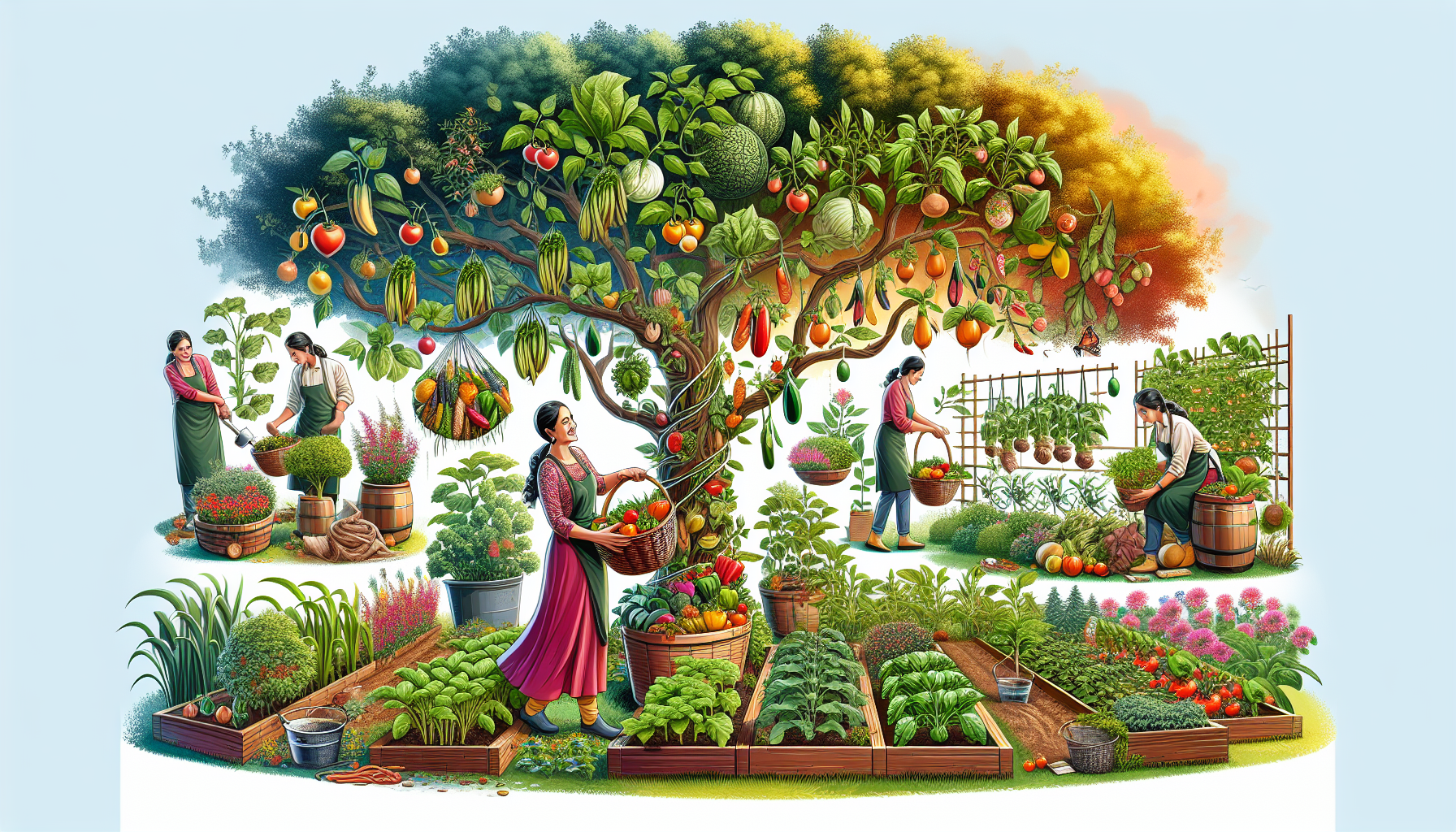Venturing into the world of vegetable gardening opens a path to not only cultivating your plot but also nourishing your well-being. This course delves deep into the arable art of creating a thriving vegetable garden. From the initial stages of selecting the right location to the joys of harvesting your own food, we explore the steps to build a garden that not only blooms with produce but also becomes a sanctuary of sustainability. Covering the necessities of garden planning, the intricacies of soil preparation, and the pivotal moments of plant care and harvesting, each lesson is designed to equip you with the green thumb needed to transform a patch of earth into a verdant banquet.
Lesson 1

Planning Your Vegetable Garden for Success
Diving into the world of vegetable gardening can transform your outdoor space into a thriving hub of fresh produce and flavors. But how do you start crafting this leafy haven? Let’s dig into the essentials of planning your vegetable garden, ensuring that your plot not only blossoms but becomes a source of pride and joy.
Finding the Ideal Location
The quest for the perfect garden spot is akin to setting the stage for a blockbuster performance. Sunlight is the lead actor, so scout for an area that basks in its glow for most of the day. Allow your garden to flourish by avoiding the shadowy embrace of trees or buildings. Wind can be both friend and foe; a gentle breeze keeps pests at bay but a fierce gust can spell doom for delicate greens.
Feeling the earth between your fingers can tell you much about its health. Assess the soil quality with a simple test kit, or get in touch with local gardening experts for a deeper analysis. Adding compost, manure, or other organic matter can boost fertility and set the stage for a bountiful vegetable garden.
Conceptualizing Your Garden’s Design
Whether you’re dreaming of neat rows of carrots or a kaleidoscope of heirloom tomatoes, the design of your garden shapes its identity. Start by considering the size – how much land can you devote to your vegetable garden ambition? Keep functional aesthetics in mind by carving out pathways for easy access and admiration.
Choosing Your Vegetables Wisely
- Research what thrives in your region and what falls prey to local pests.
- Play to your taste buds and dietary preferences, planting what you love to eat.
- Start simple. Leafy greens, carrots, and tomatoes are forgiving for beginners.
Picking the right vegetables for your garden is critical. It’s about balancing ambition with practicality, ensuring a diverse and vibrant vegetable garden that’s teeming with life and flavor.
Making Use of WordPress Table Styling for Garden Planning
To visually organize your potential harvest, leverage tables to pair vegetables with their respective season and care levels:
| Vegetable | Season | Care Level |
|---|---|---|
| Tomatoes | Summer | Medium |
| Carrots | Spring/Fall | Low |
| Spinach | Spring/Fall | Low |
As you embark on this gardening adventure, remember that your vegetable garden is a growing, changing canvas. It’s a reflection of your care and attention, so take the time to plan it right, and you’ll reap the rewards of a lush, edible landscape.
Lesson 2

Prepping and Planting Your Vegetable Garden Oasis
Eager gardeners know that the heart of a thriving vegetable garden lies in the meticulous preparation and planting. It’s not just about sowing seeds; it’s about creating an ecosystem where your veggies can flourish. Let’s delve into the process of transforming your plot into a vibrant and productive vegetable garden.
Gathering Your Garden Gear
Before you can get your hands dirty, you need the right tools for the job. A good shovel, hand trowel, rake, and hose are the basic sidekicks for your vegetable garden journey. Opt for quality over quantity – well-made tools last longer and make your gardening work much easier.
Soil Preparation is Key
The secret to a lush vegetable garden is in the soil. Begin by clearing the ground of weeds and debris. Gently turn the soil and mix in heaps of organic matter like compost or aged manure. This act of love will enrich your soil, ensuring that nutrients are plentiful for your upcoming crops.
The Art of Sowing Vegetable Seeds
With a canvas of prepared soil, it’s time to sow your seeds. Each seed packet comes with a unique set of instructions – follow them closely for the best results. Some seeds can go directly into the garden, while others might need a head start indoors. Patience and care here will lead to germination and growth that’s both rewarding and exciting.
Watering, Weeding, and War Against Pests
Once your seeds are nestled in the soil, establish a watering regime that keeps the ground moist but not waterlogged. Keep an eagle eye out for weeds and remove them promptly; they compete with your plants for resources. Protect your verdant vegetable garden using natural pest control methods to ensure your veggies remain healthy and unchewed.
Companion Planting Table
Companion planting can boost your garden’s health and yield. Here’s a simple guide to which plants work well together, formatted in a WordPress table:
| Vegetable | Companion | Benefits |
|---|---|---|
| Tomatoes | Basil | Repels pests, enhanced flavor |
| Carrots | Chives | Repels carrot fly |
| Spinach | Strawberries | Ground cover, weed prevention |
Your journey doesn’t end with the planting. A vegetable garden is a living, growing entity that requires attention and devotion. But fostering this connection with the earth is more than just practical; it’s immensely satisfying. So keep nurturing your garden, and soon, you’ll enjoy the rich bounty that nature can provide.
Lesson 3

Harvesting and Sustaining Your Lush Vegetable Garden
Revel in the fruits of your labor by mastering the final steps to sustain and enjoy your vegetable garden. Now, as your garden brims with vibrant life, understanding the nuances of care and harvesting can make all the difference in enjoying a robust bounty throughout the seasons. Here’s how to keep your vegetable garden flourishing with love and care.
Nourishing Your Plants to Perfection
Your vegetable garden is almost like a child; it grows and thrives on regular feedings. The right balance of fertilizer, natural if possible, offers your veggies the essential nutrients they crave. Pay attention to signs your plants give, like yellowing leaves or stunted growth, which can indicate nutrient deficiencies.
The Joy of the Harvest
Imagine the satisfaction as you gently pluck a ripe tomato from the vine. Knowing when and how to harvest isn’t just satisfying, it’s critical for yield. Most vegetables are at their peak of flavor just before full maturity. Timely harvesting also encourages plants to continue producing, extending the longevity of your vegetable garden.
Garden to Table: A Feast of Freshness
Why garden if not for the scrumptious rewards? Transform your freshly picked vegetables into culinary masterpieces. Explore the realm of possibilities with simple, healthy recipes to share with family and friends. Your vegetable garden is your private farmer’s market, offering you a farm-to-fork experience in your backyard.
Eco-Friendly Tips for Seasonal Transition
As the season wanes, your vegetable garden needs to be pampered for its next performance. Begin composting to recycle nutrients back into the soil. Replenishing your garden with compost ensures a fertile foundation for the next crop. Reflect on the season’s successes and learnings to plan the next round of planting. Each season is an opportunity to grow in knowledge and experience.
In nurturing your vegetable garden, you create a slice of Eden in your backyard. One that feeds both body and soul. With each season, you’ll discover more about the delicate balance of nature and the rewarding joy of hands-on harvests. The cycle of sowing, growing, and reaping is a profound journey that enriches life, plate, and planet.
Vegetable gardening is a journey that transforms your outdoor space into a tableau of taste and sustainability. As we wrap up this course, you have gained the insights and skills to build, tend, and harvest your own vegetable garden. You’ve learned to create a garden plan, prepare the soil, choose the right vegetables, care for your plants, and finally, savor the success of your harvest. Armed with this knowledge, you are now ready to cultivate a garden that can sustain not just your table but the environment as well. To verify your newfound expertise, don’t forget to take the 10-question quiz below and test your knowledge. May your harvests be bountiful and your days be filled with the quiet joy of gardening.
Test Your Knowledge With this short Quiz
Click here to copy your score to share on facebook!







